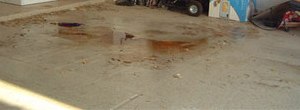As with most projects the efforts put into preparing the concrete floor before actually painting will ensure that the paint adheres, is smooth and will last for many years.
Note 1: The paint and other chemicals that are required for this project can be extremely toxic. If at all possible, paint with the garage door open. It is important that you ensure proper ventilation and wear, vinyl or rubber gloves and eye protection.
Note 2: There are many varieties of porch and floor paint. Epoxy based floor paint has the added advantage that it will help prevent cracks from forming and protect the surface from wear. Epoxy concrete paint is definitely recommended for garage floors.
Figures 1 and 2 show a concrete garage floor before and after painting with an epoxy paint.

Figure 1 - Garage floor before painting
Preparation:
- Remove everything from the garage walls and floors. Having an open space to work with, rather than moving things around, or bumping into them, as you are painting, will make the job easier in the long run.
- Clean the concrete, all stains dirt and grime must be removed as the paint will not adhere to these contaminants.
- Sweep garage
- Damp mop to remove any dust
- Stains can be removed by mixing 3 parts water with 1 part bleach or you can purchase a formulated concrete cleaner (read and follow manufacturer's instructions and safety guidelines). Use a wire brush on heavily stained areas. Use eye protection and vinyl or rubber gloves.
- The use of a pressure washer will speed up the cleaning process.
- Thoroughly rinse the floor with clean water to ensure that any residue from the bleach or concrete cleaner has been removed. Take special note to rinse the corners.
- Repair any cracks or surface blemishes in the concrete. Make sure that you read the manufacturers instructions, on any products that you use pertaining to safety and the length of curing time before painting.
Additional information on Repairing Cracks In Concrete.
- Check the surface of the concrete to ensure that it will accept the paint.
Additional information on Resurfacing Concrete.
- Place a few drops of water on the concrete in different locations. It is important to test both high and low traffic areas of the concrete floor. Areas that have high traffic may be in a better condition to accept paint because of surface wear than areas with low traffic. If the water is absorbed into the concrete than the surface can be painted. If the water sits on the surface of the concrete it will be necessary to etch the concrete.
- Etching concrete: You can purchase concrete etching products from your local building center. Follow the manufacturer's instructions very closely!
- Rinse the surface of the concrete to remove any etching chemicals.
- The floor must be completely dry before proceeding. It is suggested that you allow the concrete floor to dry overnight before painting.
- Use a paint primer or undercoat that is made specifically for the finished paint coat.
Many individuals will use an inexpensive primer or undercoat in order to save a few dollars. It is better to use a high quality undercoat or primer and an inexpensive paint for the finished coat than the other way around!
Apply the primer or undercoat per the manufacturer's instructions. Use the proper materials for brushes and rollers. If you are using an epoxy paint the correct material for brushes is nylon and for rollers you want to choose those that are lint free. Follow the manufacturer's instructions on the useable ambient temperature and the length of drying time before applying the finished coat.
Additional information on Paint Primers & Undercoats.
- Apply the first finished coat. Make sure you do not paint yourself into a corner!
- Allow the first coat to dry thoroughly (read and follow the manufacturer's recommendations for drying time). Apply the second finish coat. Two coats of paint on top of the primer should be more than sufficient.
- Allow the second finished coat to dry completely before walking on it. This is usually a minimum of 24 hours. Allow at least a full week before driving a vehicle on the surface.
Additional information on painting concrete.
